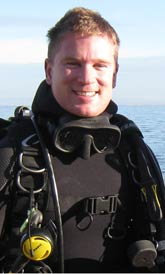« November 2010 | Main | January 2011 »
December 22, 2010
U.S. Senate Approves Shark Conservation Bill
Yesterday, the U.S. Senate approved the Shark Conservation Act, which aims to resolve loopholes in a shark finning law passed more than 10 years ago. The act requires "any vessel to land sharks with their fins attached" and would prevent non-fishing vessels from transporting fins without their carcasses, according to Washington Reporter Juliet Eilperin.
To garner North Carolina Senator Richard Burr's support, an exemption was made allowing people catching smooth dogfish off the state's coast "to bring in fins separately, as long as they account for no more than 12 percent of the total weight of the catch."
While most environmentalists reportedly support the act, it is still uncertain whether or not President Obama will sign it.
Posted by jroualdes at 09:48 PM | Comments (0)
December 11, 2010
Point Lobos Dive Profile
Often called "the crown jewel of the State Park System," Point Lobos State Natural Reserve is one of Northern California's most beautiful and diverse dive sites.
Point Lobos is located in Monterey County, three miles south of Carmel on Highway 1. It opens daily at 8 am and closes a half hour after sunset. An entrance fee of $10 per vehicle ($50 per van or small coach) and $10 per diver is charged.
Two-diver teams are allowed to dive Whalers and Bluefish Coves by reservation only. Check the dive calendar before making your reservation to identify which days are available. If you don't make your reseravation several weeks in advance, good luck. Spots fill up quickly. For those of you who don't heed my advice and chose instead to show up at Point Lobos without a reservation only to be turned away, try Monastary Beach just North of Point Lobos. Worth noting is that reservations aren't transferable or refundable.
On Nov. 24, my brother Garrett and friend Tim dove Whalers Cove. Two days earlier, a storm tore through Northern California. That morning though, we were greeted by sunny skies as we pulled into the parking lot. At the end of the parking lot, there's a staircase that leads to a lookout. I recommend every diver survey Point Lobos and plan their dive from this lookout before entering the water. Despite the sunny skies, three to six foot swells crashed into pinnacles just outside Whalers Cove, sending white wash exploding into the sky. To dive safely, we had to dive well away from the pinnacles or risk being thrown into them.
I love diving Point Lobos. But there's one thing I dislike about it--the surface swim. Without a DPV or boat, divers must surface swim roughly 50 yards from the entry point to the South-West point of Whalers Cove before descending because the visibility is often poor in the cove. During the summer, the surface swim can be a pain due to the increased kelp. That doesn't bother me though. What does is being exposed on the surface, where I'm vulnerable to great white sharks. I know, I know. I've read the statistics and I know how unlikely being attacked by a shark is. However, that's probably what Marco Flag was thinking on June 30, 1995, when he was attacked by a great white shark at Blue Fish Cove--the cove adjacent to Whalers Cove. Fortunately, Marco wasn't injured because the shark's jaws clamped down on his tank and a box attached to the front of his weight belt. While I'll likely never see a great white shark outside the Monterey Bay Aquarium, I still like to limit the time I spend on the surface.
After returning from the lookout, we emptied our gear from the car onto two picnic benches. Unlikle Lover's Point and Breakwater, Point Lobos has no grass and the parking lot is comprised of dirt. I recommend divers place their gear on the picnic tables to keep everything clean. While gearing up, an old man walked by us and said, "You're getting into the water. Little cold. Hope you don't die." I thought to myself... not exactly what you want to hear before a dive.
A few minutes later, we entered the water. We surface swam out to the South-West Point, made sure there was no kelp below us, took a compass heading off the pinnacles, then descended. "Crap," I thought to myself as I sunk to the bottom. Less than five feet of visibility, less than one minute into the dive and I've already lost sight of Garrett. Needless to say, conditions were less than stellar. A minute of two later, and we were all back together. Our plan was to swim on the compas heading to the pinnacles along a sand channel, then turn around on our recipracle and head back. Surge was stronger than expected, kicking up walls of sand.
Ten minutes later, we'd descended to 45 ft., the temprature was dropping and conditions hadn't improved. That's when we decided to head South, rathern than proceeding West along the sand channel. We hoped that conditions were better inside the kelp beds along the point. It was a gamble we're all glad we took. Five minutes later we entered the kelp beds just outside Whalers Cove and we're rewarded with nearly 40 ft. of visibility. We spotted a five-foot long leapord shark, which appeared out of nowhere, then slowly swam in between the kelp stocks and out of sight. We also stumbled across a wolf eel hunting in the open. I'd never seen a wolf eel before, and was surprised by it's size--about four feet long and stocky in comparison to a moray eel.
Nearly an hour later, we reluctantly surfaced. On our surface swim back, we each enthusiastically recounted our favorite parts from the dive. Despite poor conditions initially, it turned out to be another great Point Lobos dive.
Here's the video from our dive:
Whalers Cove from Joe Roualdes on Vimeo.
Posted by jroualdes at 12:32 AM | Comments (0)
December 08, 2010
Maui: Black Rock Dive Profile
One of my favorite Maui dive sites is Black Rock--a large lava rock that divides Kannapali Beach. It's known for being a great spot for night dives, cliff jumping and seeing some of Maui's biggest green sea turtles.
Black Rock is nearly 200 yards in length, running North-South. At its deepest it's only 30 ft. It's flanked by a reef that roughly 30 yards wide. Before diving Black Rock, contact Lahaina Divers and ask about the dive conditions. If the swell is coming from the South, conditions will likely be ideal. If the swell is coming from the North, be careful. The current at the North point of Black Rock has pulled divers out to the channel seperating Maui and Molokai.
It has two entry points, North of South. Unfortunatley, parking isn't easy. I recommend divers drive all the way to the North end of Kannapali Parkway, just past the entrance to the Sheraton Maui Resort and Spa. Park the car, remove your gear and place it on the grass next to the golf course. Make sure someone stays with the gear while the driver parks the car. Driving South on Kannapali Parkway, there is a small, I repeat, small parking lot North of Whalers Village. Parking is usually avilable before 9 am. After that, good luck.
Gear up on the grass, then walk along the path towards the Beach. There is beach access after you cross the bridge over the golf course fresh water runoff canal. Once you're at the beach, double check your dive gear and then enter the water.
You'll swim South along the North point of Black Rock. The first thing you'll notice is that the brakish fresh water from the golf course mixes wit the salt water--creating an onion-soup like mess that reduces visisbility. Stay the course! It quickly clears up. Swimming South, Black Rock will be on your left. I recommend swimming close to the wall on your way down, then swimming to the outside of the reef on your way back.
Along the wall there, are numerous small caves that green sea turtles use for shelter. During my last trip, my girlfriend Carolina and I nearly aborted our dive due to laughter when we stumbled upon a turtle at least 5 ft. long with its head stuck in a tiny hole and the rest of its body out in the open. While this defense may work for ostriches, it doesn't work for green sea turtles.
The small holes littering Black Rock are also a favorite home for moray eels. I've seen moray's on almost every dive I've made there. I've even seen multiple ones sharing the same hole. While moray eels are beautiful, they also bite, so be careful not to get too close.
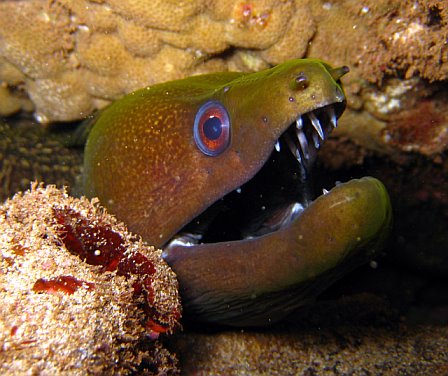
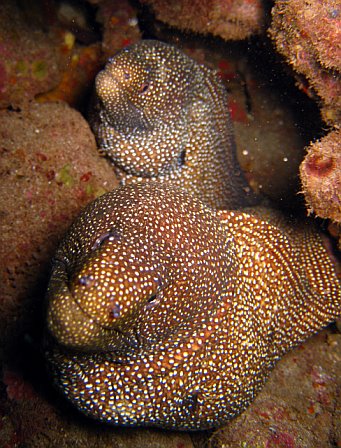
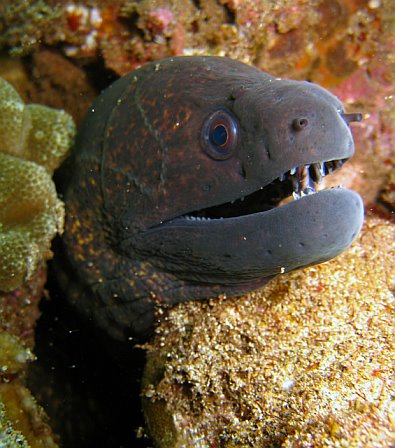
Also keep your eyes peeled for small, brightly colored objects that don't quite fit in with their surroundings. They're likely frog fish--a type of anglerfish. Frogfish are a favorite subject for photographers and videographers, but it's not because of their looks. Frogfish are stocky, ranging in size from 1-15 inches long. Their brightly colored bodies have no scales and are covered in algae or hydrozoa to help them blend in with their surroundings. Frogfish use their pectoral and pelvic fins like hands to hold themselves in place on a reef or walk along the sea floor and hunt by lying motionless until prey approaches. Then, in a fraction of a second, they open their mouths, take a deep breathe and swallow their prey whole.
For me, a trip to Black Rock isn't complete without seeing at least one frogfish.
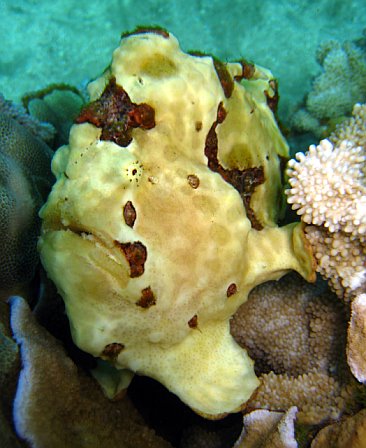
Work your way down Black Rock until you reach the South-most point. You'll know you're there when the wall takes a sharp turn left, running East, and you see people diving into the water. Then, turn around and head back North. I recommend sticking to the outside of the reef this time, instead of hugging the wall.
Keep an eye out for green sea turtles. Sometimes I like to sit in the sand at the South Point of Black Rock waiting for them to swim by. On a single dive one afternoon I counted 14 turtles swimming South. I'm not sure why, but the green sea turtles seem to use Black Rock as a South-bound highway in the late afternoons.
On the outside of the reef you'll likely come across several green sea turtles resting in the sand. While most will swim away when approached, some are inquisitive. During the last dive I made at Black Rock, a turtle crawled across the sand towards me, stopped, then lifted its face to my mask. Inches away, the green sea turtle analyzed my mask for several minutes. It is one of my most memorable diving experiences.
I hope your dives at Black Rock are as memorable as mine.
Posted by jroualdes at 10:32 PM | Comments (0)
December 06, 2010
The Making of Under the Sea 3D
What weighs 1,200 lbs., cost $5,000 to operate for three minutes and requires the film to be changed every three minutes? If you guessed Howard Hall's IMAX underwater camera system, you're right. He recently posted a video to his VIMEO account showing his team using the camera system, which he says is "the most impractical underwater camera system ever invented," to film great white sharks in South Australia for the IMAX film Under the Sea 3D.
That means Hall's IMAX underwater system weighs as much as a horse and the 40 minutes of footage from the movie cost roughly $65,000 to produce.
What I like most about the VIMEO video is that it includes communications between Hall's team captured by Ocean Technology Systems underwater communications devices embedded in their rebreather mouthpieces.
Three minutes and nine seconds into the film, Hall turns his back on a great white shark. A female diver, who I assume is Hall's wife Michele, says, "behind you." Hall responds with, "I never saw that one coming," which draws laughs from his team.
Here is the video:
Filming Great Whites from Howard Hall on Vimeo.
Posted by jroualdes at 03:06 AM | Comments (0) | TrackBack








